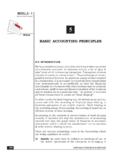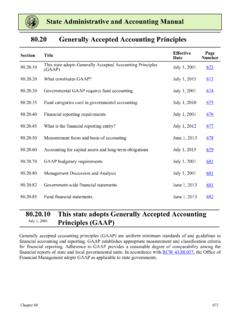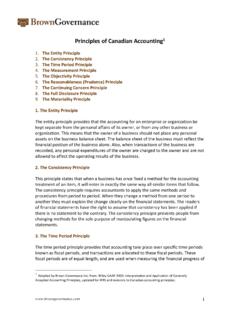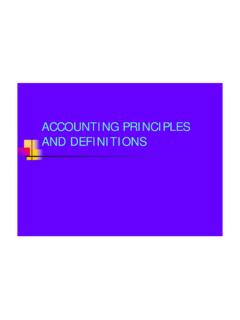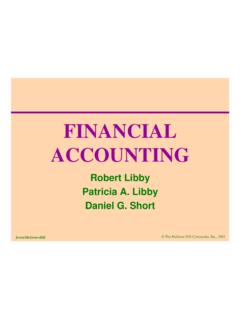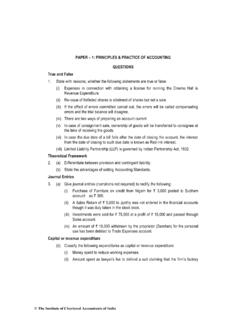Transcription of Principles of Managerial Accounting
1 Principles ofACCOUNTINGMANAGERIALC hristine Jonick, ofACCOUNTINGMANAGERIALC hristine Jonick, Ridge | Cumming | Dahlonega | Gainesville | OconeePrinciples of Managerial Accounting is licensed under a Creative Commons Attribution-ShareAlike International license allows you to remix, tweak, and build upon this work, even commercially, as long as you credit this original source for the creation and license the new creation under identical you reuse this content elsewhere, in order to comply with the attribution requirements of the license please attribute the original source to the University System of : The above copyright license which University System of Georgia uses for their original content does not extend to or include content which was accessed and incorporated, and which is licensed under various other CC Licenses, such as ND licenses.
2 Nor does it extend to or include any Special Permissions which were granted to us by the rightsholders for our use of their content. Image Disclaimer: All images and figures in this book are believed to be (after a reasonable investigation) either public domain or carry a compatible Creative Commons license. If you are the copyright owner of images in this book and you have not authorized the use of your work under these terms, please contact the University of North Georgia Press at to have the content by:University of North Georgia PressDahlonega, GeorgiaCover Design and Layout Design:Corey ParsonCover Image:Scott Rodgerson, CC0 ISBN: 978-1-940771-45-8 Printed in the United States of America, 2017 For more information, please visit: email: you need this document in another format, please email the University of North Georgia Press at or call OF CONTENTSC hapter 1: Managerial Accounting ConCepts Introduction.
3 Cost terminology and concepts .. Inventory terminology and 2: Job order Costing Comprehensive Example of Job Order Costing Transactions for a Manufacturing Job Order Costing for a Service 3: proCess Costing Process Costing Transactions for a Manufacturing Process Costing Calculations for a Department in a Manufacturing Company ..36 Chapter 4: aCtivity-based Costing Single factory rate to estimate factory Departmental rates to estimate factory Activity-based costing for a manufacturing business to estimate factory overhead .. Differences based on factory overhead Activity-based costing for a manufacturing business to estimate factory overhead .. Activity-based costing for a service business to estimate factory overhead.
4 49 Chapter 5: Cost voluMe profit analysis Cost Volume Profit Analysis (CVP).. Breakeven Point .. Operating leverage .. Margin of 6: variable Costing analysis Units manufactured equals units sold .. Units manufactured greater than units sold .. Units manufactured less than units sold .. Analysis of variable and absorption Contribution margin analysis ..74 Chapter 7: budgeting Static Budget .. Flexible Budget .. Master Budget .. Operating Budget .. Sales Cost of Goods Sold Selling and Administrative Cost Budgeted Income Statement .. Cash Capital Expenditure Budget ..96 Chapter 8: varianCe analysis Direct materials cost Direct labor cost variance .. Factory overhead 9: differential analysis Make or buy a component part.
5 Continue with or discontinue a Lease or sell equipment .. Sell a product or process Keep or replace a fixed asset .. Accept business at reduced Capital investment | 1 1 Managerial Accounting Concepts INTRODUCTIONA ccounting is the system of recording and keeping track of financial transactions in a business and summarizing this information in reports. These reports provide information to people who are interested in knowing about the financial aspects of a business . The information guides business managers, investors, and creditors in planning and decision making. In fact, Accounting is often referred to as the language of business because business people communicate, evaluate performance, and determine value using dollars and amounts generated by the Accounting Accounting involves producing periodic reports called financial statements to inform such external groups as investors, boards of directors, creditors, and government/tax agencies about a company s financial performance and status.
6 The income statement, retained earnings statement, balance sheet, and statement of cash flows are published at fixed intervals to summarize the historical earnings performance and current financial position of a company. Financial statements are prepared according to Generally Accepted Accounting Principles (GAAP), which helps ensure the information is relevant (useful and timely for making decisions), reliable (accurate and unbiased), consistent (prepared the same way each time information is reported), and comparable (prepared the same way by different companies). Managerial Accounting is targeted more toward a company s managers and employees. The information gathered and summarized for these internal groups is customized to provide feedback for planning, decision making, and evaluation purposes.
7 Managerial reports do not necessarily follow any particular format, but instead are uniquely designed to meet the needs of specific users. Analyses are often focused on targeted segments of a business rather than on a company as a whole. Information may be published over periodic time intervals or on an as-need basis. Managerial Accounting involves not only actual financial data from past periods, but also current estimates and future manager s responsibilities in a business include making decisions related to planning (identifying goals and strategies for accomplishing them), leading (directing daily operations and carrying out plans), and controlling (comparing Page | 2 Principles OF Managerial ACCOUNTINGMANAGERIAL Accounting CONCEPTS expected and actual results and taking action for improvement).
8 Since human, financial, and time resources are limited, managers must select from among many alternatives, foregoing other options. They try to optimize the collective outcome of their choices. Managerial Accounting provides timely and relevant financial information that contributes to effective decision business s operations are classified as one of three types - service, merchandising, or manufacturing - depending on what it has for sale. A service business sells expertise, advice, assistance, professional skills, or an experience rather than a physical product. A merchandising business purchases finished and packaged products from other companies, marks up the costs of these items, and sells them to customers.
9 A manufacturing business assembles and packages products for sale to merchandisers or end users. Managerial Accounting is relevant to all three types of businesses. In this document, we will focus on manufacturing since that type of business involves the most in-depth facets and examples of Managerial Accounting . We will also discuss Managerial Accounting for service businesses where appropriate. Topics will fall into four broad categories: accumulating costs, analyzing costs, evaluating performance, and comparing goal of a business is to generate profit, which is the difference between income and costs in a particular time period. Costs are the result of paying cash or committing to pay cash in the future in order to earn revenue.
10 Costs may be accumulated for a product, sales territory, department, or activity. It is critical to analyze costs because controlling them directly impacts profitability. Costs are also used to determine selling prices of products, and they are monitored over time to evaluate progress and discover irregularities. ACCUMULATING COSTSC osts must be determined and recorded accurately, systematically, and on a timely basis. Unless cost information is correct and reliable, it is not very useful to managers who depend on it to make effective plans and informed decisions. Job order costing and process costing are two methods of systematically accumulating costs on manufactured products.








